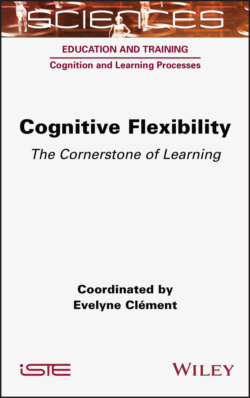Cognitive Flexibility

Реклама. ООО «ЛитРес», ИНН: 7719571260.
Оглавление
Evelyne Clement. Cognitive Flexibility
Table of Contents
List of Illustrations
List of Tables
Guide
Pages
Cognitive Flexibility. The Cornerstone of Learning
Introduction
1. Measures of Flexibility
1.1. Introduction
1.2. Why measure flexibility? 1.2.1. Cognitive flexibility in everyday life
1.2.2. Associated pathologies
1.3. How can we measure flexibility?
1.3.1. The different types of assessment
1.3.1.1. Direct evaluations. 1.3.1.1.1. Historical and classical tasks
1.3.1.1.2. Executive function assessment batteries
1.3.1.1.3. More playful tasks
1.3.1.2. Indirect assessments
1.3.2. Which measure for which flexibility?
1.4. Conclusion
1.5. References
2. Development of Cognitive Flexibility
2.1. Introduction
2.2. Main study paradigms and some developmental points of reference
2.3. How can we account for perseveration behaviors in the preschool years?
2.4. Beyond perseveration
2.5. Flexibility: a question of goal management
2.5.1. Goal maintenance
2.5.2. The processing of goal cues
2.5.3. Toward an optimal sequencing of the information gathering process: from reactive to proactive control
2.5.4. Metacognition and processing of goal cues
2.6. From imposed flexibility to self-regulated flexibility
2.7. Conclusion
2.8. References
3. Metacognition and Flexibility: What are the Theoretical Links and What Links have been Observed?
3.1. Introduction
3.2. Metacognition
3.3. Executive functions
3.4. The common features between metacognition and executive functions. 3.4.1. Conceptual common features
3.4.2. Empirical results on the links between metacognition and executive functions
3.4.3. The links between flexibility and metacognition
3.5. Conclusion
3.6. References
4. Critical Thinking and Flexibility
4.1. Introduction
4.2. Characterizing critical thinking to foster its development
4.2.1. Philosophical approaches
4.2.2. Psychological approaches
4.2.3. Forms of critical thinking education
4.3. The critical mind, a flexible mind?
4.3.1. The cognitive building blocks of critical thinking
4.3.2. Changing the perspective
4.3.3. The role of metacognition
4.3.4. Barriers to flexibility: the role of intuitive conceptions and inappropriate categorizations
4.4. Developing critical thinking skills through multiple categorization
4.4.1. Multiple categorization
4.4.2. Operationalization through research in a school context
4.5. Conclusion
4.6. References
5. Successful Solution Discovery and Cognitive Flexibility
5.1. Introduction
5.2. Cognitive flexibility in problem solving. 5.2.1. What is defined as a problem?
5.2.2. Familiar knowledge about the world, problem solving and transfer. 5.2.2.1. The crucial role of prior knowledge
5.2.2.2. Positive, negative or no transfer
5.2.3. Strategic flexibility, representational flexibility and solution discovery
5.2.3.1. Research in mathematics education
5.2.3.2. Research conducted in psychology
5.3. Flexibility, creativity and academic performance
5.3.1. Flexibility and creativity: what links?
5.3.2. Cognitive flexibility and academic performance
5.3.3. Creativity and academic performance
5.4. Conclusion
5.5. References
6. Transfer of Learning and Flexibility in Childhood
6.1. Introduction
6.1.1. The child who transfers: a little history
6.1.2. Surface, structure, context
6.2. Transfer of learning: a developmental overview
6.2.1. The transfer of perceptual properties
6.2.2. Transfer by imitation
6.2.3. Solution transfer by analogy
6.2.4. The transfer of cognitive strategies
6.3. Transfer and flexibility
6.3.1. Transfer and conceptual flexibility
6.3.2. Transfer and attentional flexibility
6.3.2.1. Strategic transfer and flexibility
6.3.2.2. A special case: transfer utilization deficiencies
6.4. Conclusion
6.5. References
7. Cognitive Flexibility and Analogy
7.1. Introduction
7.2. The role of prior knowledge in analogy. 7.2.1. Analogy: encoding, retrieval and mapping
7.2.2. Prior knowledge and encoding
7.2.3. Prior knowledge and analogical retrieval
7.2.4. Prior knowledge and mapping
7.3. Cognitive flexibility as a key process in analogy-making. 7.3.1. The abstract recoding process
7.3.2. Abstract recoding and the implementation of challenging analogies
7.3.3. Comparison to promote flexibility and analogy
7.4. Conclusion
7.5. References
8. Context, Content Effects and Flexibility
8.1. Introduction
8.2. Context, concepts and flexibility. 8.2.1. The categorical ambiguity of concepts
8.2.2. The role of prior knowledge
8.3. Representing situations and tasks. 8.3.1. Problem solving in the service of the study of reasoning
8.3.2. The notion of problem representation
8.3.3. Content effects as mediators of flexibility?
8.3.4. Robust influences
8.4. Semantic recoding and cognitive flexibility. 8.4.1. Semantic recoding, a lever for flexibility in school?
8.4.2. New perspectives to explore
8.5. Conclusion
8.6. References
List of Authors
Index. A
B, C
D, E
F
G, I
L, M
P
R, S
T
U, W
WILEY END USER LICENSE AGREEMENT
Отрывок из книги
Education and Training, Field Director – Jean-Marc Labat
.....
As we have been able to demonstrate (Maintenant et al. 2013; Maintenant and Pennequin 2016), in the field of categorial flexibility, switching in a controlled manner from one mode of categorization to another involves not only the executive aspects inherent to this activity (flexibility, inhibition), but also the conceptualization of the modes of categorization to be used. The quality of the representation and the level of mastery of the activities, which we must switch between during a flexibility task, are therefore crucial and must be taken into account during an assessment.
As already proposed by Karmiloff-Smith (1992, 1994), cognitive flexibility implies a possibility of representational redescription. Whether it is in the context of an assessment by a task switching situation or in the context of an assessment by categorial flexibility or problem-solving tasks (Clément 2006; Clément and Gavornikova-Baligand 2010), it seems to emerge from these measures of cognitive flexibility that it is necessary to represent the same object or the same situation in different ways. Cognitive flexibility thus seems to imply “re” representing a stimulus, with different levels of possible conceptual representations, from the lowest level, such as learned associations between cues and specific responses (task switching) to higher levels, such as problem-solving situations involving a modification of the conceptualization of a situation.
.....